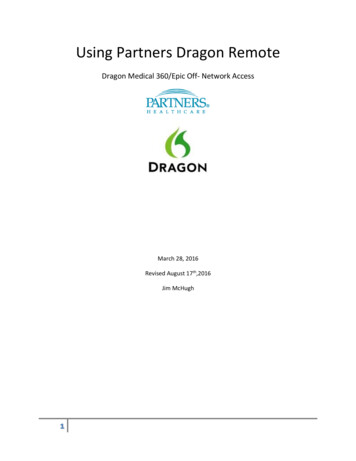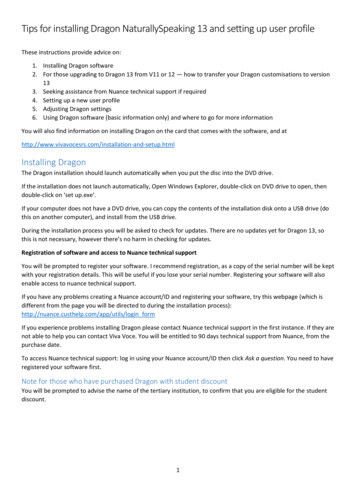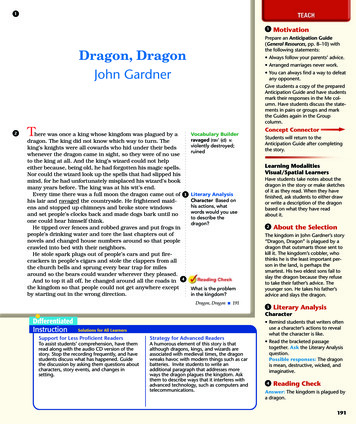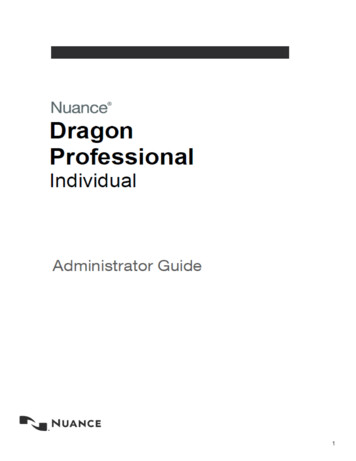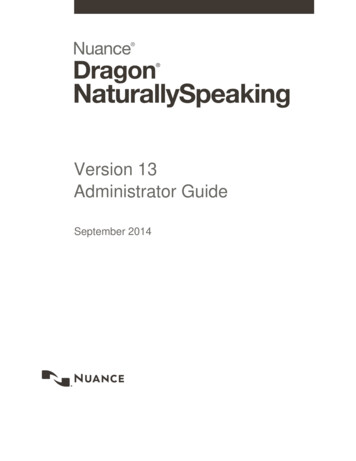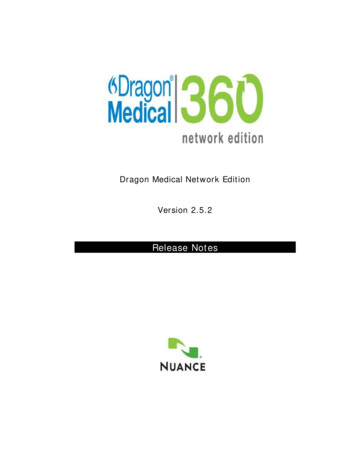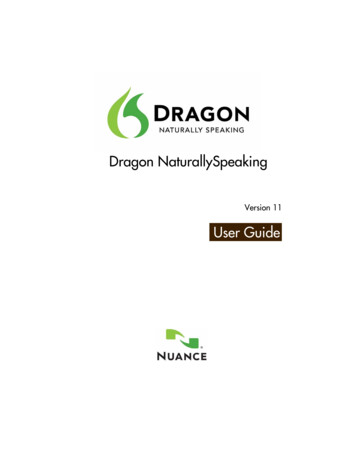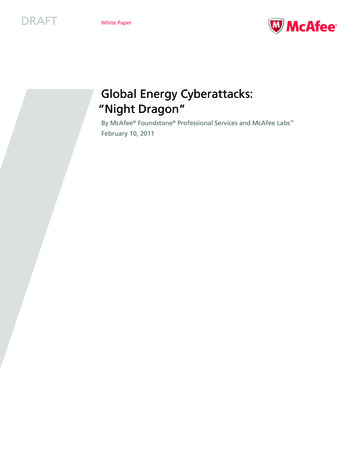
Transcription
DRAFTWhite PaperGlobal Energy Cyberattacks:“Night Dragon”By McAfee Foundstone Professional Services and McAfee Labs February 10, 2011
DRAFTWhite PaperGlobal Energy Cyberattacks: “Night Dragon”Table of ContentsExecutive Summary3Anatomy of a Hack3Details of the Attack4Use of remote administration tools7Detection7Host Files and Registry Keys8Anti-virus Alerts9Network Communications9Additional Detection Techniques11McAfee Early Detection11McAfee Detection12McAfee Prevention12Conclusion13Credits and Acknowledgements13Appendix A: zwShell — the RAT13Appendix B: Attribution18Version 1.1 Feb 10, 2011 09:28 AM
DRAFTWhite PaperGlobal Energy Cyberattacks: “Night Dragon”Executive SummaryIn 2010, we entered a new decade in the world of cybersecurity. The prior decade was stained withimmaturity, reactive technical solutions, and a lack of security sophistication that promoted criticaloutbreaks, such as Code Red, Nimda, Blaster, Sasser, SQL Slammer, Conficker, and myDoom—to name afew. The security community has evolved and grown smarter about security, safe computing, and systemhardening but so have our adversaries. This decade is setting up to be the exponential jumping off point.The adversaries are rapidly leveraging productized malware toolkits that let them develop more malwarethan in all prior years combined, and they have matured from the prior decade to release the mostinsidious and persistent cyberthreats ever known.The Google hacks (“Operation Aurora”), named by McAfee and announced in January 2010, and theWikiLeaks document disclosures of 2010 have highlighted the fact that external and internal threatsare nearly impossible to prevent. Miscreants continue to infiltrate networks and exfiltrate sensitive andproprietary data upon which the world’s economies depend every day. When a new attack emerges,security vendors cannot stand by idly and watch. We are obligated to share our findings to protect thosenot yet impacted and to repair those who have been. As such, McAfee Foundstone Professional Servicesand McAfee Labs decided to release the following discovery.Starting in November 2009, coordinated covert and targeted cyberattacks have been conducted againstglobal oil, energy, and petrochemical companies. These attacks have involved social engineering, spearphishing attacks, exploitation of Microsoft Windows operating systems vulnerabilities, Microsoft ActiveDirectory compromises, and the use of remote administration tools (RATs) in targeting and harvestingsensitive competitive proprietary operations and project-financing information with regard to oil and gasfield bids and operations. We have identified the tools, techniques, and network activities used in thesecontinuing attacks — which we have dubbed Night Dragon — as originating primarily in China. Throughcoordinated analysis of the related events and tools used, McAfee has determined identifying featuresto assist companies with detection and investigation. While we believe many actors have participatedin these attacks, we have been able to identify one individual who has provided the crucial C&Cinfrastructure to the attackers. (See Appendix B for more detail on attribution.)Anatomy of a Hack12345Extranet webserverscompromisedGained accessto sensitiveinternaldesktops andserversAccessedadditionalusernames andpasswordsEnabled directcommunicationfrom infectedmachines to theInternetExfiltrated emailarchives andother sensitivedocumentsRemotecommandexecutionHacker toolsuploaded toserversFurther accessto sensitivedocumentsNIGHTDRAGONDisabled IEproxy settingsExecutives’computerscompromisedFigure 1. Anatomy of a hack.3
DRAFTWhite PaperGlobal Energy Cyberattacks: “Night Dragon”The Night Dragon attacks work by methodical and progressive intrusions into the targeted infrastructure.The following basic activities were performed by the Night Dragon operation: Company extranet web servers compromised through SQL-injection techniques, allowing remotecommand execution Commonly available hacker tools are uploaded on compromised web servers, allowing attackers topivot into the company’s intranet and giving them access to sensitive desktops and servers internally Using password cracking and pass-the-hash tools, attackers gain additional usernames and passwords,allowing them to obtain further authenticated access to sensitive internal desktops and servers Initially using the company’s compromised web servers as command and control (C&C) servers, theattackers discovered that they needed only to disable Microsoft Internet Explorer (IE) proxy settingsto allow direct communication from infected machines to the Internet Using the RAT malware, they proceeded to connect to other machines (targeting executives)and exfiltrating email archives and other sensitive documentsDetails of the AttackAttackers using several locations in China have leveraged C&C servers on purchased hosted services inthe United States and compromised servers in the Netherlands to wage attacks against global oil, gas,and petrochemical companies, as well as individuals and executives in Kazakhstan, Taiwan, Greece, andthe United States to acquire proprietary and highly confidential information. The primary operationaltechnique used by the attackers comprised a variety of hacker tools, including privately developed andcustomized RAT tools that provided complete remote administration capabilities to the attacker. RATsprovide functions similar to Citrix or Microsoft Windows Terminal Services, allowing a remote individualto completely control the affected system.To deploy these tools, attackers first compromised perimeter security controls, through SQL-injectionexploits of extranet web servers, as well as targeted spear-phishing attacks of mobile worker laptops,and compromising corporate VPN accounts to penetrate the targeted company’s defensive architectures(DMZs and firewalls) and conduct reconnaissance of targeted companies’ networked computers.SQL Injection Attacks(1) Attacker crafts a HTTP GETrequest to inject commands to SQLserver to gain system-level access(2) Malware is placed on server andused to harvest the local and ActiveDirectory account credentialsWebSQLInternetAD(4) Attacker uses RAT malware toconduct additional reconnaissanceand systems compromises and toharvest confidential dataC&C(3) Active Directory accounts areused to access network computersand plant RAT malware that connectswith remote C&C addresses.Figure 2. SQL-injection attacks.4
DRAFTWhite PaperGlobal Energy Cyberattacks: “Night Dragon”Spear-Phishing Attacks(1) Attacker sends a spear-phishingemail containing a link to acompromised web server(2) User opens infected email andthe compromised website isaccessed; a RAT is downloadedWebEmailInternet(4) Attacker uses RAT malware toconduct additional reconnaissanceand systems compromises and toharvest confidential dataC&C(3) User account information andhost configuration information issent to a C&C serverFigure 3. Spear-phishing attacks.Many Chinese hacker websites offer these tools for download, including links to reduh, WebShell,ASPXSpy, and many others, plus exploits and zero-day malware.Figure 4. Rootkin.net.cn offers access to an endless list of hacker tools and exploits.5
DRAFTWhite PaperGlobal Energy Cyberattacks: “Night Dragon”Figure 5. WebShell and ASPXSpy tools allow an attacker to bypass many firewallrules to funnel all control through a company’s web server.6
DRAFTWhite PaperGlobal Energy Cyberattacks: “Night Dragon”Once the initial system was compromised, the attackers compromised local administrator accounts andActive Directory administrator (and administrative users) accounts. The attackers often used commonWindows utilities, such as SysInternals tools (acquired by Microsoft in 2006) — and other publicly availablesoftware, including hacking tools developed in China and widely available on Chinese undergroundhacker websites — to establish “backdoors” through reverse proxies and planted Trojans that allowed theattackers to bypass network and host security policies and settings. Desktop anti-virus and anti-spywaretools were also disabled in some instances — a common technique of targeted attacks.Use of remote administration toolsRemote administration tools (RATs) are commonly used administrative tools that allow hackers (andadministrators) to manage victims’ computers (or managed systems) and completely control their useand function. A commonly used RAT in the hacker community is Gh0st and its many variants. RATfeatures often include screen and webcam spying, keystroke logging, mouse control, file/registry,and process management, and, of course, remote command shell capability.McAfee has identified several RATs that have been used to establish a persistent infiltration channel intocompromised companies. One of the most prevalent RATs is zwShell, which McAfee has seen in the wildsince the spring of 2010 (compiled on 2010-03-17 08:47:00). Written in the Delphi language, zwShellwas used by attackers to both build custom variants of the Trojan that they deployed on dozens ofmachines within each victim company, as well as to control compromised machines that would initiatebeacon connections to it on a custom protocol.Attackers used zwShell extensively to generate dozens of unique Trojan variants and to control theinfected machines and exfiltrate sensitive data directly from them. (See Appendix A for a breakdownof the zwShell.)Once the attackers had complete control of the targeted internal system, they dumped account hasheswith gsecdump and used the Cain & Abel tool to crack the hashes to leverage them in targeting evermore sensitive infrastructures.Files of interest focused on operational oil and gas field production systems and financial documentsrelated to field exploration and bidding that were later copied from the compromised hosts or viaextranet servers. In some cases, the files were copied to and downloaded from company web serversby the attackers. In certain cases, the attackers collected data from SCADA systems.DetectionThe methods and tools used in these attacks are relatively unsophisticated, as they simply appear tobe standard host administration techniques, using standard administrative credentials. This is largelywhy they are able to evade detection by standard security software and network policies. Since theinitial compromises, however, many individual unique signatures have been identified for the Trojanand associated tools by security vendors, including McAfee; yet only through recent analysis andthe discovery of common artifacts and evidence correlation have we been able to determine that adedicated effort has been ongoing for at least two years, and likely as many as four. We can nowassociate the various signatures to these events.The following artifacts can help to determine whether a company has been compromised: Host files and/or registry keys Anti-virus alerts Network communications7
DRAFTWhite PaperGlobal Energy Cyberattacks: “Night Dragon”Host Files and Registry KeysUtilityDescriptionCommand &control jan dropperA packaged executable customized to each victim that includes the DLL file and configuration settingsfor installing the backdoor on the remote system.The dropper can be run from any directory and is usually executed with PSEXEC or an RDP session.Thus, related Windows Security Event logs provide useful information concerning compromised ActiveDirectory accounts. These logs can be reviewed with Windows Event Log Manager or programs, suchas “Event Log Explorer” or EnCase, which support search capabilities.When executed, the dropper creates a temporary file that is reflected in Windows update logs(KB*.log files in c:\Windows folder).This is because the Windows Registry is modified by the dropper to create a “netsvcs” key. Accordingly,the date of the backdoor installation can be determined from a search of the KB log files. This temporaryfile is also identified in the backdoor DLL itself. The temporary file is usually some alphanumericcombination that includes “gzg” (for example, xgt0gzg); however, it has been seen with generic filenames (for example, server.exe) as well.The dropper is deleted when the backdoor is installed, and the temporary file is removed when thecomputer is restarted. If a backdoor has already been configured on the system, the dropper installationwill fail unless it uses a different configuration.Trojan backdoorDynamic link libraries (DLLs), also appearing under many other names.These files have a correlated Windows Registry key that is determined by the dropper when the backdooris installed. The dropper iterates through the Windows netsvcs registry keys and uses the first availablekey, indicating the path and filename of the backdoor in a ServiceDLL register. The backdoor operates asa service through a “svchost.exe netsvcs –k” registry setting. The service key can be found under:HKLM\system\ controlset \services\The DLL is a system or hidden file, 19 KB to 23 KB in size and includes an XOR-encoded data section thatis defined by the C&C application when the dropper is created. It includes the network service identifier,registry service key, service description, mutex name, C&C server address, port, and dropper temporaryfile name. The backdoor may operate from any configured TCP port.This DLL is specified in the ServiceDLL key in the related Windows netsvcs registry entry. The DLL is usuallyfound in the %System%\System32 or %System%\SysWow64 directory.Trojan backdoor ally configured with the 855Connect.dll creates the temporary file “HostID.DAT,” which is sent to the C&C server, then downloadsand configures related DLLs including: PluginFile.dll PluginScreen.dll PluginCmd.dll PluginKeyboard.dll PluginProcess.dll PluginService.dll PluginRegedit.dllThereafter “Startup.dll” operates the service under a Windows Registry key. All communications seenso far with this version have been on ports 25 and 80 over TCP but can operate on any determined port.The service key is identified in the DLL (which does not include any encrypted data) as:HKLM\Software\RATThis DLL is usually found in the %System%\System32 directory; however, it has also been found in otherlocations. The path to the backdoor DLL is indicated in the Windows Registry ServiceDLL key.*This DLL uses a different C&C application that may be an earlier versionof zwShell, analysis continues.8
DRAFTWhite PaperGlobal Energy Cyberattacks: “Night Dragon”The Trojan components are manually copied or delivered through administrative utilities to remote systems.They do not include any worm or self-replicating features, nor can the Trojan “infect” other computers.Removing the Trojan components is simply a matter of deleting the related files and registry settings.The Trojan backdoor communicates with the C&C server at the address hard-coded in each DLL. The C&Cserver cannot modify the backdoor once it is installed; related systems must have the Trojan file removedbefore a new backdoor DLL can be installed on the system. Thus, if the C&C server address is changed,those servers that have the DLL with previous addresses must be remotely administered by the attacker.Anti-virus AlertsAnti-virus patterns are defined according to samples submitted by clients or analysts as they arediscovered. Some Trojans exhibit characteristics of other types of malware, such as worms or viruses,that have the ability to infect other systems. RATs do not typically include such features, and, becausethey are defined with unique configurations for custom purposes, they commonly change faster thanunique samples can be identified.Only when an entire RAT toolkit is found can we define an anti-virus pattern that is generic enoughto detect the RAT regardless of configuration changes. The package necessarily includes the C&Capplication server, the generator utility for creating droppers, related droppers, and backdoors —and a sufficient number of each to correlate the toolkit.As mentioned previously, there have been several unique patterns developed from samples submittedto McAfee (as well as to other anti-virus vendors).McAfee recommends that companies review McAfee ePolicy Orchestrator (McAfee ePO ) software and anti-virus logs for “NightDragon” signaturedetections to identify related alerts since 2007 and then recover and resubmitthese samples for analysis to investigate the related incidents. McAfee canassist with the analysis or provide instructions and tools for internal review.Network CommunicationsNetwork communications are relatively easy to detect because the malware uses a unique host beaconand server response protocol. Each communication packet between the compromised host and the C&Cserver is signed with a plain text signature of “hW .” (or “\x68\x57\x24\x13”) at the byte offset 0x42within the TCP packet.The backdoor begins its beacon at approximately five-second intervals with an initial packet that maybe detected with the pattern: “\x01\x50[\x00-\xff] \x68\x57\x24\x13.”9
DRAFTWhite PaperGlobal Energy Cyberattacks: “Night Dragon”The server acknowledges the beacon with an initial response of “\x01\x60[\x00-\xff] \x68\x57\x24\x13.”The backdoor sends the password to the server in clear text after the server acknowledges the connection.While the backdoor and the server have an active connection, the backdoor will send “keep-alive”messages that can be detected with: “\x03\x50[\x00-\xff] \x68\x57\x24\x13.”10
DRAFTWhite PaperGlobal Energy Cyberattacks: “Night Dragon”The attackers use “dynamic DNS” Internet name services accounts to relay C&C communications ortemporarily associate DNS addresses with remote servers. Primary domains that have been used forC&C traffic include (all of these have been used frequently by other malware): is-a-chef.com thruhere.net office-on-the.net selfip.comCompany extranet servers have also been used as either unique or secondary/redundant C&C servers. Insome instances, the attackers have (probably mistakenly) used droppers configured to compromise onecompany’s computers — in another company’s computers.McAfee recommends that companies configure intrusion detection system(IDS) rules to detect the noted signatures (or employ the user-defined signature[UDS] “BACKDOOR: NightDragon Communication Detected” in McAfeeNetwork Security Platform) and monitor DNS for outbound communications todynamic DNS addresses resolving to or pathed back as suballocated to serversin China, where the company’s name or common abbreviation forms the firstpart of the address. This may be difficult. However, if samples of the backdoorDLLs are found, DNS monitoring can help to identify other compromised hostsin the company network. McAfee also recommends that companies reviewweb or IDS logs for file transfers to addresses registered in China. McAfee canassist with the analysis or provide instructions and tools for internal review.Additional Detection TechniquesThe backdoor beacons with its corresponding C&C server as long as the related address is active. If theaddress is abandoned or unreachable, the backdoor stops beaconing after some undetermined interval.When a compromised computer is restarted, however, the beaconing begins again because it is registeredas a service in the Windows Registry. Anti-virus may or may not detect the Trojan unless it is beaconing ora full file system scan is performed.McAfee Early DetectionCustomers can deploy a number of McAfee products to help protect information systems from the NightDragon attack: McAfee Vulnerability Manager: Using agentless discovery and vulnerability checking to assess systemson your network, McAfee Vulnerability Manager is an enterprise-class vulnerability managementsystem that will detect infected Night Dragon systems as well as the security weaknesses in systemsthat have been compromised. The “wham-apt-nightdragon-detected-v7.fasl3” script will detect thisthreat remotely on systems. McAfee Policy Auditor: Using agent-based configuration audit checks to determine the most secureconfiguration of a system, McAfee Policy Auditor software detects the security weaknesses in thesystems that have been compromised McAfee Risk Advisory (MRA): Properly deployed, McAfee Risk Advisor would have allowed administratorsto see the misconfigurations and gap in security coverage that facilitated Night Dragon’s exploitation11
DRAFTWhite PaperGlobal Energy Cyberattacks: “Night Dragon”McAfee DetectionNight Dragon also displays a pattern of correlated activities with an assortment of other software toolsthat McAfee can assist companies to identify. McAfee VirusScan Enterprise: Update your anti-virus .DATs to at least version 6232 and ensure thaton-demand scans are working properly and perform a full file system virus scan. Review McAfee ePOsoftware or anti-virus alerts and network logs for “NightDragon” signature detections to identifycompromised systems. Please submit any related samples to virus research@mcafee.com or submiton the web at https://www.webimmune.net/default.asp. McAfee Network Threat Response: McAfee Network Threat Response technology would have detectedthe malicious C&C traffic and would have alerted administrators to the attack early, giving them timeto react and prevent future damageAdministrators can also download the following free tools from McAfee: McAfee “Night Dragon Vulnerability Scanner” based on McAfee Vulnerability Manager technology toscan their networks for the presence of malware McAfee Labs StingerMcAfee PreventionFor complete prevention of this and most other attacks involving advanced persistent threats (APTs),customers can deploy application whitelisting and change/configuration control software on their criticalservers. These technologies completely prevent the unauthorized running of DLLs/EXEs as well as themodification of registry keys, services, and more involved in all of today’s APT and zero-day attacks. McAfee Application Control: McAfee Application Control software stops Night Dragon by not allowingthe dropper files from executing (even as administrator on Windows), thereby preventing downloads ofadditional malware and the setup of C&C channels that allowing RAT control and theft of sensitive files McAfee Configuration Control: McAfee Configuration Control software allows you to disallowany configuration changes to your systems, protecting them from being modified without explicitpermission (even with administrative access) McAfee Database Activity Monitoring: delivers complete database protection including 0-day attacksand web born attacks such as those seen with SQL injection in Night Dragon. McAfee Network Security Manager: With the correct UDS signature set installed, the McAfee NetworkSecurity Platform appliances provide protection against network-based attacks, such as Night Dragon,by detecting malicious traffic on the network and alerting administrators to give them time to respondand prevent future attacks McAfee Enterprise Firewall: Properly installed and configured at the border and inside your organization,McAfee Firewall would have prevented the Night Dragon operation from penetrating so deeply intothe affected organizations and would have blocked C&C communication from the RAT McAfee Web Gateway: Properly installed and configured, McAfee Web Gateway would have preventedthe Night Dragon operation from using their RATs, requiring them to proxy-enable their RATs or usealternative proxy-enabled RATs McAfee Endpoint Encryption: Properly installed and configured, McAfee Endpoint Encryption softwarereduces the impact of the Night Dragon attack by restricting access to the core targeted assets McAfee Data Loss Protection: Properly installed and configured, McAfee Network DLP and/or McAfeeHost DLP solutions allow you to prevent and detect the extraction of sensitive information from outsidethe company12
DRAFTWhite PaperGlobal Energy Cyberattacks: “Night Dragon” McAfee Host Intrusion Prevention 8.0: McAfee Host Intrusion Prevention 8.0 software has introduceda new “TrustedSource” APT detection feature that allows enterprises to correlate endpoint executableactivity with the network C&C communication to detect and prevent RAT communications and dataexfiltration activity McAfee VirusScan Enterprise: In addition to detecting associated malware and RATs on the endpoint,customers can also leverage access protection features in McAfee VirusScan Enterprise to prevent(and alert on) the creation of Night Dragon-related files and folder structures. Other built-in featuressuch infection tracing and McAfee Global Threat Intelligence can assist with the identification andquarantining or removal of new and unknown associated malware and RATs.If you have discovered the presence of Night Dragon in your environment and would like incident-responseor forensics assistance to respond and repair, please contact Foundstone Professional Services onincidentresponse@foundstone.com or submit any related samples to Virus Research@avertlabs.comor on the web at McAfee Labs WebImmune.ConclusionWell-coordinated, targeted attacks such as Night Dragon, orchestrated by a growing group of maliciousattackers committed to their targets, are rapidly on the rise. These targets have now moved beyond thedefense industrial base, government, and military computers to include global corporate and commercialtargets. While Night Dragon attacks focused specifically on the energy sector, the tools and techniquesof this kind can be highly successful when targeting any industry. Our experience has shown that manyother industries are currently vulnerable and are under continuous and persistent cyberespionageattacks of this type. More and more, these attacks focus not on using and abusing machines within theorganizations being compromised, but rather on the theft of specific data and intellectual property. It isvital that organizations work proactively toward protecting the heart of their value: intellectual property.Enterprises need to take action to discover these assets in their environments, assess their configurationsfor vulnerabilities, and protect them from misuse and attack.For additional research and information, review Hacking Exposed: Network Secret and Solutions — 6thEdition (Osborne McGraw-Hill). You can also visit http://www.hackingexposed.com for information onadvanced hacker techniques and to sign up for “Hacking Exposed” monthly webinars.Credits and AcknowledgementsThe preceding white paper was a collaborative effort among numerous people and entities includingMcAfee Foundstone Professional Services consultants, McAfee Labs, McAfee employees, executives, andresearchers, HBGary and National Cyber-Forensics & Training Alliance (NCFTA). Significant contributorsinclude Shane Shook, Dmitri Alperovitch, Stuart McClure, Georg Wicherski, Greg Hoglund, Shawn Bracken,Ryan Permeh, Vitaly Zaytsev, Mark Gilbert, Mike Spohn, George Kurtz, and Adam Meyers.13
DRAFTWhite PaperGlobal Energy Cyberattacks: “Night Dragon”Appendix A: zwShell — the RATBelow is a walk-through of the capabilities of zwShell and a demonstration of how the attackers usedzwShell as a command and control server to exfiltrate data from within the targeted companies.1. When zwShell is launched, it presents a fake crash error to the user and contains a hidden text entryfield below the “Write of address 00000000. Process stopped” line. By entering the password inthe hidden dialog box above the “ok” button to launch the application requires typing a specialpassword, “zw.china.” Without that password, the tool will not start. This obfuscation method islikely used to confuse investigators about the true purpose of this executable.2. Once the error is bypassed, and zwShell is launched, it allows the attacker to create a custom Trojan byselecting the Server menu or to launch the C&C server by clicking Start and entering the port to listen fortraffic with the password used by the backdoor DLLs. Once started, the application will begin listeningfor incoming compromised client connections and display them inside the grid. The attacker can launchas many instances of the zwShell application as required — as long as each listens to a different port orpassword. In this manner, multiple “networks” of compromised computers can be monitored.3. The attacker can also click on the Options menu to configure the C&C server settings. Those settingsinclude selection of the listening port, the password that will encrypt the C&C traffic (which mustmatch the password selected at the time of the Trojan generation), the ability to specify custom soundnotifications for when infected machines connect and disconnect from the C&C server, and the abilityto increase the color depth used for remote access to the machine, as well as an optional capabilityto allow resumes of interrupted file transfers from the client machine. The attacker can stop thelistener and start with new options to monitor or connect with other compromised computers.14
DRAFTWhite PaperGlobal Energy Cyberattacks: “Night Dragon”4. The attacker can specify the password (which must match the password set up for the server in Step 3),the name and path to the RAT DLL that will be injected into the svchost.exe Windows services process,the service and mutex names, and service displayed name and description. The attacker can also specifyup to two C&C hostnames or IP address, port address, and dropper EXE process icon. Once theCreate button is clicked, zwShell will generate a custom EXE dropper process which, when executed,will delete itself and extract a RAT DLL that will be launched as a persistent Windows service. TheRAT will then immediately send a beacon on the configured port to the designated C&C server andwait for instructions.5. The dropp
3 DRAFT White Paper Global Energy Cyberattacks: “Night Dragon” Executive Summary In 2010, we entered a new decade in the world of cybersecurity. The prior decade was stained with immaturity, reactive technical solutions, and

